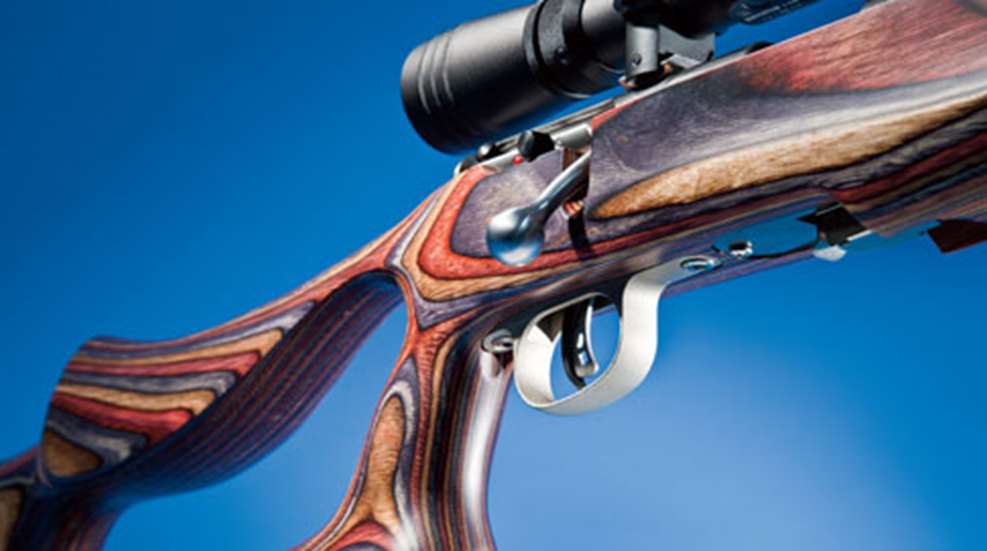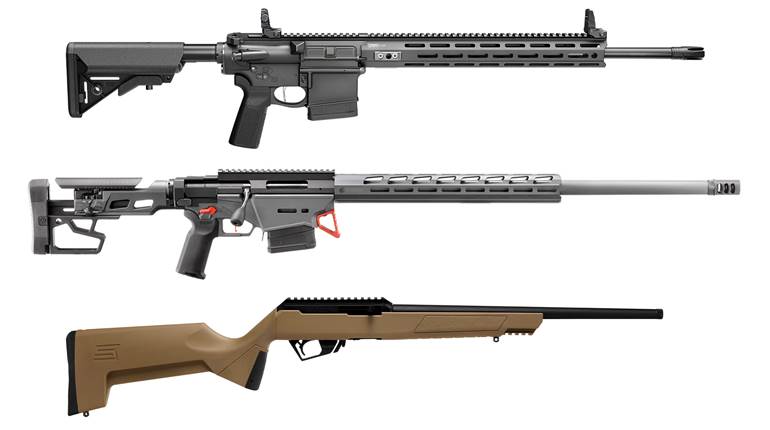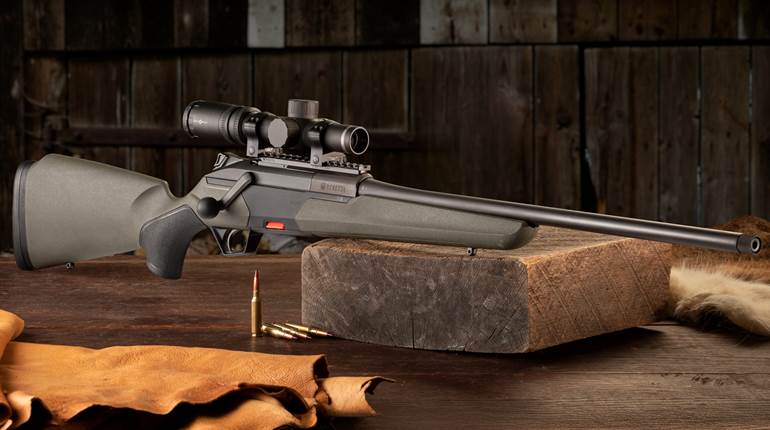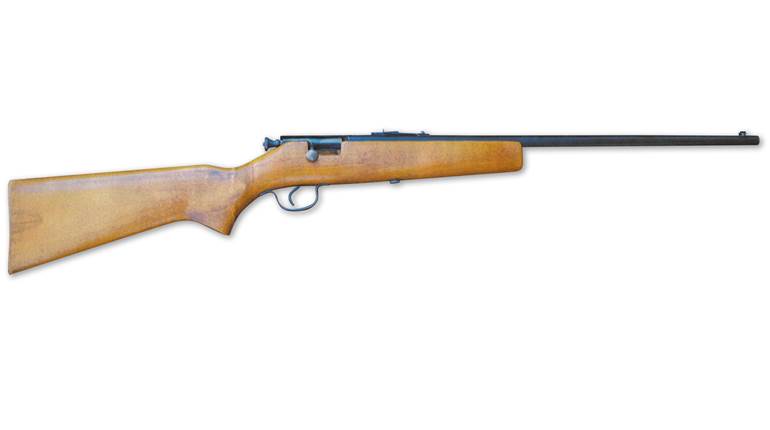
Savage Arms is renowned for manufacturing firearms that are not only accurate, but also conservative in price and classic in styling; however, with regard to appearances, many of its product lines depart from the norm. Perhaps the most telling examples of this are found in the identically styled Mark II BSEV (.22 Long Rifle), 93 BSEV (.22 WMR), and 93R17 BSEV (.17 HMR). The former is evaluated here.
Unconventional in nearly every way, the Mark II BSEV (with “B” representing a laminated stock, “S” for stainless steel, and “EV” a Boyd’s Evolution stock) is designed to appeal to a different consumer—one demanding the utmost in performance but also an edgier appearance. Although aesthetically pleasing, many of the features contributing to the gun’s appeal also enhance the platform’s accuracy potential. Take the barrel for example.
The 21-inch tube is button-rifled in a 1:16-inch rate of twist in a right-hand pattern and ends in a target-style recessed muzzle crown. Its combination of 416R stainless steel and spiral fluting is visually striking. And its stout profile, measuring 0.801 inches in diameter throughout, and free-floating attachment contribute to the rifle’s accuracy. Although slightly reducing weight and facilitating quicker cooling (really, how hot can a .22 Long Rifle-chambered bolt-action rifle get?), the fluting is more cosmetic than functional. Like the barrel, the Mark II BSEV’s satin-finished receiver is machined from round bar stock, thereby simplifying manufacture and reducing cost. Located on the right rear side of the receiver is the two-position safety; pushed forward reveals a red dot, indicating the rifle is ready to fire, while in the rear position an “S” is exposed, denoting “Safe.” As the barrel is devoid of sights, the receiver is drilled and tapped for scope bases. Savage includes two Weaver-style bases with the rifle.
The bolt, which is also fashioned from stainless steel and has a satin finish, features what appear to be dual extractors; however, only the right side is the true extractor. That on the left acts as a stabilizer to keep the cartridge straight. Ejection is achieved by a fixed ejector that fits into a channel machined into the bolt, and with the bolt fully rearward, projects past its face. The rearward-sweeping bolt handle features a smooth bolt knob.
Nicely complementing the stainless steel receiver, barrel, trigger guard, which is cast, and bottom metal is a unique Boyd’s Evolution stock. Hues of brown, blue/gray, and red give the rifle a distinctive appearance. Further accentuating this is the abbreviated fore-end. Unlike a traditional fore-end the Evolution’s ends at approximately one-third of the barrel’s length and does not contact it. It has palm-filling dimensions at the receiver and tapers significantly along its length. The detachable, five-round-capacity, stamped metal magazine is located at the stock’s thickest point. A 10-round version is also available. A simple metal tab acts as the magazine catch.
The butt of the stock is equally unconventional. It is skeletonized, reducing its weight slightly and lending a visually pleasing form. It has the same palm-filling grip of a traditional thumbhole stock, but with more appeal. The comb resembles an upside-down Monte Carlo-style, and it too aligns the eye for use with an optic. Capping the buttstock is a 0.60-inch-thick rubber recoil pad. Although unnecessary for recoil, its non-slip surface helps keep the rifle on the shoulder. It is worthy of note that the Mark II BSEV has no sling swivel studs.
No doubt some of the Mark II BSEV’s accuracy can be attributed to its AccuTrigger. It can be adjusted from 2 pounds, 8 ounces to 5 pounds, 8 ounces. The test rifle’s trigger broke crisply at 2 pounds, 4 ounces.
Occasionally during firearm evaluations for these pages a real gem is unveiled; such was the case with the Mark II BSEV. Using three brands of ammunition, two of which were match-grade, from a Caldwell Lead Sled Solo, the rifle exhibited above-average accuracy. Of the loads selected Lapua Midas+ was the standout, averaging 0.39 of an inch for five consecutive, five-shot groups at 50 yards. Not far behind was SK Standard Plus, which averaged 0.50 of an inch.
During testing there were no failures to feed, extract or eject; however, there were two failures to fire—one each with Lapua and SK. Examining the cartridges revealed deep indentions. Re-chambering the rounds, thus exposing new areas to the firing pin, allowed both to fire on the second attempt.
Regardless of its outward appearance, the Mark II BSEV is pure Savage, as it exhibited remarkable accuracy. Anyone in the market for a literal tack-driving .22 Long Rifle-chambered rifle, but with added flare, should take a look at the Mark II BSEV. It’s hard to miss.
Manufacturer: Savage Arms; (413) 642-4262; www.savagearms.com
Caliber: .22 Long Rifle
Action Type: bolt-action, repeating rimfire rifle
Receiver: 416R stainless steel
Barrel Length: 21"
Rifling: 1:16" RH twist, button-rifled
Magazine: five-round detachable box
Sights: none; Weaver-style scope bases included
Trigger Pull: single-stage, adjustable, 2 lbs., 8 ozs. to 5 lbs., 8 ozs.
Stock: laminated wood: length of pull,135⁄8"; drop at heel, 211⁄16"; drop at comb, 5/8"
Overall Length: 40"
Weight: 6 lbs., 13 ozs.
Accessories: owner’s manual
Suggested Retail Price: $546





































